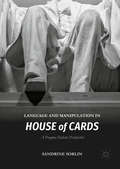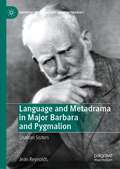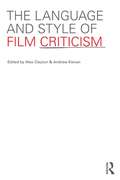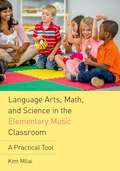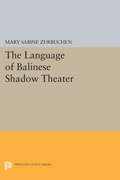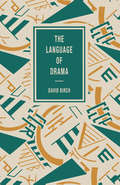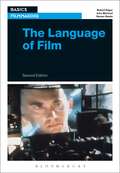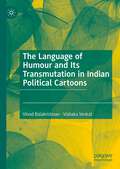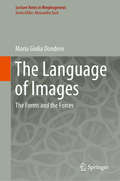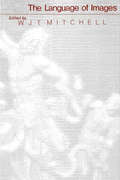- Table View
- List View
Langford's Starting Photography: The Guide to Creating Great Images
by Philip AndrewsStarting with the basics of camera control and moving on to shutter speeds, aperture, zoom and flash, Langford’s Starting Photography gives you the only introduction to digital photography you’ll ever need. Once you’ve mastered the basics, examples and projects allow you to explore the key methods for capturing a variety of subjects from portraits and pets to landscapes and sports photography, alongside straightforward advice on using editing software to get the best out of your digital shots, will have you producing unforgettable images in moments. More inspiring than a textbook, more interesting than a reference, and more in-depth than a photography class, Langford’s Starting Photography is the only guide you need to start taking great images.
Language and Manipulation in House of Cards: A Pragma-Stylistic Perspective
by Sandrine SorlinThis book is to date the first monograph-length study of the popular American political TV series House of Cards. It proposes an encompassing analysis of the first three seasons from the unusual angles of discourse and dialogue. The study of the stylistic idiosyncrasies of the ruthless main protagonist, Frank Underwood, is completed by a pragmatic and cognitive approach exposing the main characters’ manipulative strategies to win over the other. Taking into account the socio-cultural context and the specificities of the TV medium, the volume focuses on the workings of interaction as well as the impact of the direct address to the viewer. The book critically uses the latest theories in pragmatics and stylistics in its attempt at providing a pragma-rhetorical theory of manipulation.
Language and Media: A Resource Book for Students (Routledge English Language Introductions)
by Rodney H. Jones Sylvia Jaworska Erhan AslanRoutledge English Language Introductions cover core areas of language study and are one-stop resources for students. Assuming no prior knowledge, books in the series offer an accessible overview of the subject, with activities, study questions, sample analyses, commentaries, and key readings—all in the same volume. The innovative and flexible 'two-dimensional' structure is built around four sections—introduction, development, exploration, and extension— which offer self-contained stages for study. Each topic can also be read across these sections, enabling the reader to build gradually on the knowledge gained. This revised second edition of Language and Media: Provides an accessible introduction and comprehensive overview of the major approaches and methodological tools used in the study of language and media. Focuses on a broad range of media and media content from more traditional print and broadcast media formats to more recent digital media formats. Incorporates practical examples using real data, including newspaper articles, press releases, television shows, advertisements (print, broadcast, and digital), blogs, social media content, internet memes, culture jamming, and protest signs. Includes key readings from leading scholars in the field, such as Jan Blommaert, Sonia Livingstone, David Machin, Martin Montgomery, Ruth Page, Ron Scollon, and Theo van Leeuwen. Offers a wide range of activities, questions, and points for further discussion. The book emphasises the increasingly creative ways ordinary people are engaging in media production. It also addresses a number of urgent current concerns around media and media production/reception, including fake news, clickbait, virality, and surveillance. Written by three experienced teachers and authors, this accessible textbook is an essential resource for all students of English language and linguistics.
Language and Media: A Resource Book for Students (Routledge English Language Introductions)
by Rodney H. Jones Sylvia Jaworska Erhan AslanRoutledge English Language Introductions cover core areas of language study and are one-stop resources for students. Assuming no prior knowledge, books in the series offer an accessible overview of the subject, with activities, study questions, sample analyses, commentaries, and key readings—all in the same volume. The innovative and flexible 'two-dimensional' structure is built around four sections—introduction, development, exploration, and extension— which offer self-contained stages for study. Each topic can also be read across these sections, enabling the reader to build gradually on the knowledge gained. This revised second edition of Language and Media: Provides an accessible introduction and comprehensive overview of the major approaches and methodological tools used in the study of language and media. Focuses on a broad range of media and media content from more traditional print and broadcast media formats to more recent digital media formats. Incorporates practical examples using real data, including newspaper articles, press releases, television shows, advertisements (print, broadcast, and digital), blogs, social media content, internet memes, culture jamming, and protest signs. Includes key readings from leading scholars in the field, such as Jan Blommaert, Sonia Livingstone, David Machin, Martin Montgomery, Ruth Page, Ron Scollon, and Theo van Leeuwen. Offers a wide range of activities, questions, and points for further discussion. The book emphasises the increasingly creative ways ordinary people are engaging in media production. It also addresses a number of urgent current concerns around media and media production/reception, including fake news, clickbait, virality, and surveillance. Written by three experienced teachers and authors, this accessible textbook is an essential resource for all students of English language and linguistics.
Language and Metadrama in Major Barbara and Pygmalion: Shavian Sisters (Bernard Shaw and His Contemporaries)
by Jean ReynoldsThis book focuses on two important topics in Shaw’s Major Barbara and Pygmalion that have received little attention from critics: language and metadrama. If we look beyond the social, political, and economic issues that Shaw explored in these two plays, we discover that the stories of the two “Shavian sisters”— Barbara Undershaft and Eliza Doolittle—are deeply concerned with performance and what Jacques Derrida calls “the problem of language.” Nearly every character in Major Barbara produces, directs, or acts in at least one miniature play. In Pygmalion, Henry Higgins is Eliza’s acting coach and phonetics teacher, as well as the star of an impromptu, open-air phonetics show. The language content in these two plays is just as intriguing. Did Eliza Doolittle have to learn Standard English to become a complete human being? Should we worry about the bad grammar we hear at Barbara Undershaft’s Salvation Army shelter? Is English losing its precision and purity? Meanwhile, in the background, Shaw keeps reminding us that language and theatre are always present in our everyday lives—sometimes serving as stabilizing forces, and sometimes working to undo them.
The Language and Style of Film Criticism
by Alex Clayton Andrew KlevanThe Language and Style of Film Criticism brings together original essays from an international range of academics and film critics highlighting the achievements, complexities and potential of film criticism. In recent years, in contrast to the theoretical, historical and cultural study of film, film criticism has been relatively marginalised, especially within the academy. This book highlights the distinctiveness of film criticism and addresses ways in which it can take a more central place within the academy and develop in dynamic ways outside it. The Language and Style of Film Criticism is essential reading for academics, teachers, students and journalists who wish to understand and appreciate the language and style of film criticism.
The Language and Style of Film Criticism
by Andrew Klevan Alex ClaytonThe Language and Style of Film Criticism brings together original essays from an international range of academics and film critics highlighting the achievements, complexities and potential of film criticism. In recent years, in contrast to the theoretical, historical and cultural study of film, film criticism has been relatively marginalised, especially within the academy. This book highlights the distinctiveness of film criticism and addresses ways in which it can take a more central place within the academy and develop in dynamic ways outside it. The Language and Style of Film Criticism is essential reading for academics, teachers, students and journalists who wish to understand and appreciate the language and style of film criticism.
Language Arts, Math, and Science in the Elementary Music Classroom: A Practical Tool
by Kim MilaiLanguage Arts, Math, and Science in the Elementary Music Classroom provides a practical guide to help music teachers incorporate elementary classroom subjects into their curriculum using STEAM (Science, Technology, Engineering, Arts and Math)-inspired strategies, with added emphasis on social studies. It includes a complete elementary music curriculum for kindergarten, first, and second grades, and has cross-referencing charts for regular elementary classroom teachers to find music activities for their classroom. Importantly, it shows teachers how to include the artistic processes of creating, performing, responding, and connecting in their lessons. These processes make up the new music standards featured in NAfME's new Core Arts Music Standards. In order to maximize comprehension, the book includes assessment tests, sheet music, work sheet templates, and brainstorming activities centered on using technology to enhance composition projects. Lesson plans are organized by the calendar year, each inspired by the seasons, American culture, and world culture. These lessons may be used as is or used to generate new curricula altogether.
Language Education: Teaching English in India (Principles-based Adaptive Teaching)
by Nishevita Jayendran Anusha Ramanathan Surbhi NagpalThis book situates the teaching and learning of language in general, and English in particular, within the sociocultural context of India. It engages with current scholarship in literacy studies and the pedagogies of language acquisition and learning. The volume discusses the cultural, discursive and sociopolitical functions of language education and the teaching of English in Indian schools. It examines the importance of adopting flexible pedagogical and multimodal strategies in teaching vocabulary; grammar; literary genres like fiction, poetry and drama; rhetorical discourses; and communicative English to learners for whom English is not one of their home language(s). It also discusses pragmatic approaches to curriculum design for communicative competence and critical literacy rooted in theoretical principles of language education. The authors analyse issues relevant to secondlanguage acquisition; English language teaching (ELT); emergent, adult and critical literacies; and critical pedagogies in language and literature. Written in an accessible style, the book comes with case studies, exercises and additional references to support an independent exploration of the fields. This book will be of interest to students and teachers of language, literature and education, as well as teachers and educators in schools and universities. It is also of relevance to policymakers, non-governmental organisations and public and private sector bodies that work in the fields of language and literacy.
Language Education: Teaching English in India (Principles-based Adaptive Teaching)
by Nishevita Jayendran Anusha Ramanathan Surbhi NagpalThis book situates the teaching and learning of language in general, and English in particular, within the sociocultural context of India. It engages with current scholarship in literacy studies and the pedagogies of language acquisition and learning. The volume discusses the cultural, discursive and sociopolitical functions of language education and the teaching of English in Indian schools. It examines the importance of adopting flexible pedagogical and multimodal strategies in teaching vocabulary; grammar; literary genres like fiction, poetry and drama; rhetorical discourses; and communicative English to learners for whom English is not one of their home language(s). It also discusses pragmatic approaches to curriculum design for communicative competence and critical literacy rooted in theoretical principles of language education. The authors analyse issues relevant to secondlanguage acquisition; English language teaching (ELT); emergent, adult and critical literacies; and critical pedagogies in language and literature. Written in an accessible style, the book comes with case studies, exercises and additional references to support an independent exploration of the fields. This book will be of interest to students and teachers of language, literature and education, as well as teachers and educators in schools and universities. It is also of relevance to policymakers, non-governmental organisations and public and private sector bodies that work in the fields of language and literacy.
Language, Music, and Computing: First International Workshop, LMAC 2015, St. Petersburg, Russia, April 20-22, 2015, Revised Selected Papers (Communications in Computer and Information Science #561)
by Polina Eismont Natalia KonstantinovaThis book constitutes the proceedings of the First International Workshop on Language, Music and Computing, LMAC 2015, held in St. Petersburg, Russia, in April 2015. The 13 papers presented in this volume were carefully reviewed and selected from 38 submissions. They were organized in topical sections on music and language in education; corpus studies of language and music; problems of notation; and linguistic studies of music.
The Language of Balinese Shadow Theater
by Mary Sabine ZurbuchenBali's shadow puppet theater, like others in Southeast Asia, is a complex tradition with many conventions that puzzle Western observers. Mary Zurbuchen demonstrates how the linguistic codes of this rich art form mediate between social groups, cultural influences, historical periods, and conceptual schemes.Originally published in 1987.The Princeton Legacy Library uses the latest print-on-demand technology to again make available previously out-of-print books from the distinguished backlist of Princeton University Press. These editions preserve the original texts of these important books while presenting them in durable paperback and hardcover editions. The goal of the Princeton Legacy Library is to vastly increase access to the rich scholarly heritage found in the thousands of books published by Princeton University Press since its founding in 1905.
The Language of Cities
by Deyan SudjicThe director of the Design Museum defines the greatest artefact of all time: the cityWe live in a world that is now predominantly urban. So how do we define the city as it evolves in the twenty-first century? Drawing examples from across the globe, Deyan Sudjic decodes the underlying forces that shape our cities, such as resources and land, to the ideas that shape conscious elements of design, whether of buildings or of space. Erudite and entertaining, he considers the differences between capital cities and the rest to understand why it is that we often feel more comfortable in our identities as Londoners, Muscovites, or Mumbaikars than in our national identities.
A Language of Contemporary Architecture: An Index of Topology and Typology
by Rafael Luna Dongwoo YimAs a way to understand the contemporary project in architecture, this book provides an index of ideas, theories, projects, and definitions that string into a methodology for evaluating the contemporary language of architecture described as “contemporism” through a review of topology (form) and typology (system and elements). The contemporary project has been trying to answer the postmodern question of how to move beyond modernism through a thread of architectural styles that tried to respond to deficiencies from the modern promise and contextual changes. Yet, the question remains, should this ongoing struggle to move beyond modernism be a stylistic battle? Has the present architectural practice ever left the modernist tendencies, and is there a structure for a contemporary language in architecture? This book presents a collection of highly illustrated projects that have worked under these parameters to break away from modernism in order to present a holistic integration of topology and typology as a language for “contemporism.” The index is illustrated with individual spreads, which can be read sequentially or independently, and encourages the reader to make their own connections. It also includes interviews and contributions from Toyo Ito, Anthony Vidler, Ben van Berkel, Christian Kerez, and Greg Lynn. This book is essential reading for undergraduate and graduate students in architecture.
A Language of Contemporary Architecture: An Index of Topology and Typology
by Rafael Luna Dongwoo YimAs a way to understand the contemporary project in architecture, this book provides an index of ideas, theories, projects, and definitions that string into a methodology for evaluating the contemporary language of architecture described as “contemporism” through a review of topology (form) and typology (system and elements). The contemporary project has been trying to answer the postmodern question of how to move beyond modernism through a thread of architectural styles that tried to respond to deficiencies from the modern promise and contextual changes. Yet, the question remains, should this ongoing struggle to move beyond modernism be a stylistic battle? Has the present architectural practice ever left the modernist tendencies, and is there a structure for a contemporary language in architecture? This book presents a collection of highly illustrated projects that have worked under these parameters to break away from modernism in order to present a holistic integration of topology and typology as a language for “contemporism.” The index is illustrated with individual spreads, which can be read sequentially or independently, and encourages the reader to make their own connections. It also includes interviews and contributions from Toyo Ito, Anthony Vidler, Ben van Berkel, Christian Kerez, and Greg Lynn. This book is essential reading for undergraduate and graduate students in architecture.
The Language of Design: Theory and Computation
by Andy An-Si Dong“The Language of Design” articulates the theory that there is a language of design. Drawing upon insights from computational language processing, the language of design is modeled computationally through latent semantic analysis (LSA), lexical chain analysis (LCA), and sentiment analysis (SA). The statistical co-occurrence of semantics (LSA), semantic relations (LCA), and semantic modifiers (SA) in design text is used to illustrate how the reality producing effect of language is itself an enactment of design, allowing a new understanding of the connections between creative behaviors. The computation of the language of design makes it possible to make direct measurements of creative behaviors which are distributed across social spaces and mediated through language. The book demonstrates how machine understanding of design texts based on computation over the language of design yields practical applications for design management.
The Language of Drama (Language of Literature)
by David BirchThe Language of Drama is about the critical strategies that can be used to understand the dynamic processes of writing, reading, dramaturgy, rehearsal, production and reception of drama performance in both the classroom and the professional theatre. It draws upon many of the recent insights developed in discourse analysis, literary theory, social semiotics, popular culture studies and performance analysis, in order to present a detailed critical theory and practice of how the language of drama means as a process of drama praxis.
The Language of Dystopia (Palgrave Studies in Language, Literature and Style)
by Jessica NorledgeThis book presents an extended account of the language of dystopia, exploring the creativity and style of dystopian narratives and mapping the development of the genre from its early origins through to contemporary practice. Drawing upon stylistic, cognitive-poetic and narratological approaches, the work proposes a stylistic profile of dystopia, arguing for a reader-led discussion of genre that takes into account reader subjectivity and personal conceptualisations of prototypicality. In examining and identifying those aspects of language that characterise dystopian narratives and the experience of reading dystopian fictions, the work discusses in particular the manipulation and construction of dystopian languages, the conceptualisation of dystopian worlds, the reading of dystopian minds, the projection of dystopian ethics, the unreliability of dystopian refraction, and the evolution and hybridity of the dystopian genre.
The Language of Film (Basics Filmmaking)
by Robert Edgar John Marland Steven RawleAn effective filmmaker needs to have a good understanding of how film language works, and more importantly, how to actively influence an audience's thoughts and feelings and guide their gaze around the screen.Packed with examples from classic and contemporary cinema, The Language of Film reveals the essential building blocks of film and explains how the screen communicates meaning to its audience. You will learn about fundamental theories and concepts, including film semiotics, narrative structures, ideology, and genre, as well as how elements such as shot size, camera movement, editing technique, and color come together to create the cinematic image.With insightful case studies and discussion questions, dozens of practical tips and exercises, and a new chapter on film sound, this new edition of The Language of Film is a must-have guide for aspiring filmmakers.
The Language of Film (Basics Filmmaking Ser.)
by Robert Edgar John Marland Steven RawleAn effective filmmaker needs to have a good understanding of how film language works, and more importantly, how to actively influence an audience's thoughts and feelings and guide their gaze around the screen.Packed with examples from classic and contemporary cinema, The Language of Film reveals the essential building blocks of film and explains how the screen communicates meaning to its audience. You will learn about fundamental theories and concepts, including film semiotics, narrative structures, ideology, and genre, as well as how elements such as shot size, camera movement, editing technique, and color come together to create the cinematic image.With insightful case studies and discussion questions, dozens of practical tips and exercises, and a new chapter on film sound, this new edition of The Language of Film is a must-have guide for aspiring filmmakers.
The Language of Food: Through the Lens of East Asian Films and Drama (Routledge Studies in East Asian Translation)
by Jieun Kiaer Loli Kim Niamh CalwayThe Language of Food: Through the Lens of East Asian Films and Drama invites readers into the fascinating world where food culture and language intersect, revealing how each dish communicates beyond mere taste.Through East Asian films and television shows, this book uncovers the rich tapestry of 'food languages' embedded within East Asian cultures. Divided into three parts – Base, Ingredients, and Seasoning – this book provides a structured exploration of this phenomenon. The Base section offers philosophical and historical context, while the Ingredients section delves deeper into specific themes, using examples from film and television drama to illustrate the nuanced communication inherent in food culture. Finally, the book is 'seasoned' with linguistic insights and a practical food words glossary, aiding readers in navigating the intricate verbal and cultural nuances at play. This illuminating resource goes beyond the realm of food itself, offering a profound understanding of how each dish carries its language, enriching communication and deepening cultural connections.This book will captivate students and researchers of East Asian languages, media studies, film studies, food studies, and Korean Wave studies and anyone intrigued by the intricate relationship between food and language.
The Language of Food: Through the Lens of East Asian Films and Drama (Routledge Studies in East Asian Translation)
by Jieun Kiaer Loli Kim Niamh CalwayThe Language of Food: Through the Lens of East Asian Films and Drama invites readers into the fascinating world where food culture and language intersect, revealing how each dish communicates beyond mere taste.Through East Asian films and television shows, this book uncovers the rich tapestry of 'food languages' embedded within East Asian cultures. Divided into three parts – Base, Ingredients, and Seasoning – this book provides a structured exploration of this phenomenon. The Base section offers philosophical and historical context, while the Ingredients section delves deeper into specific themes, using examples from film and television drama to illustrate the nuanced communication inherent in food culture. Finally, the book is 'seasoned' with linguistic insights and a practical food words glossary, aiding readers in navigating the intricate verbal and cultural nuances at play. This illuminating resource goes beyond the realm of food itself, offering a profound understanding of how each dish carries its language, enriching communication and deepening cultural connections.This book will captivate students and researchers of East Asian languages, media studies, film studies, food studies, and Korean Wave studies and anyone intrigued by the intricate relationship between food and language.
The Language of Humour and Its Transmutation in Indian Political Cartoons
by Vinod Balakrishnan Vishaka VenkatThis book develops a model to examine the language of humour, which is multimodal and accounts for the possibility of transmutation of humour as it is performed through editorial cartoons. By transmutation is meant the transition in the language of humour when it crosses its own boundaries to provoke unprecedented reactions resulting in offensiveness, disappointment or hurt sentiment. The transmutability about the language of humour points to its inherently diabolical nature which manifests in the performance of controversial cartoons. The model is built by borrowing theoretical cues from Roman Jakobson, Roland Barthes, George Lakoff and Mark Johnson. The integrated model, then, is developed to examine the cartoons which were recommended for deletion by the Thorat Committee, following a cartoon controversy in India. Through the cartoon analysis, the model discerns the significance of context and temporality in determining the impact of humour. It also examines how the ethics of humour; the blurred lines of political correctness and incorrectness are dictated by the political atmosphere and the power dynamics.
The Language of Images: The Forms and the Forces (Lecture Notes in Morphogenesis)
by Maria Giulia DonderoThis book deals with two fundamental issues in the semiotics of the image. The first is the relationship between image and observer: how does one look at an image? To answer this question, this book sets out to transpose the theory of enunciation formulated in linguistics over to the visual field. It also aims to clarify the gains made in contemporary visual semiotics relative to the semiology of Roland Barthes and Emile Benveniste. The second issue addressed is the relation between the forces, forms and materiality of the images. How do different physical mediums (pictorial, photographic and digital) influence visual forms? How does materiality affect the generativity of forms? On the forces within the images, the book addresses the philosophical thought of Gilles Deleuze and René Thom as well as the experiment of Aby Warburg’s Atlas Mnemosyne. The theories discussed in the book are tested on a variety of corpora for analysis, including both paintings and photographs, taken from traditional as well as contemporary sources in a variety of social sectors (arts and sciences). Finally, semiotic methodology is contrasted with the computational analysis of large collections of images (Big Data), such as the “Media Visualization” analyses proposed by Lev Manovich and Cultural Analytics in the field of Computer Science to evaluate the impact of automatic analysis of visual forms on Digital Art History and more generally on the image sciences.
The Language of Images (A Critical Inquiry Book)
by W. J. Mitchell"A remarkably rich and provocative set of essays on the virtually infinite kinds of meanings generated by images in both the verbal and visual arts. Ranging from Michelangelo to Velazquez and Delacroix, from the art of the emblem book to the history of photography and film, The Language of Images offers at once new ways of thinking about the inexhaustibly complex relation between verbal and iconic representation."—James A. W. Heffernan, Dartmouth College

